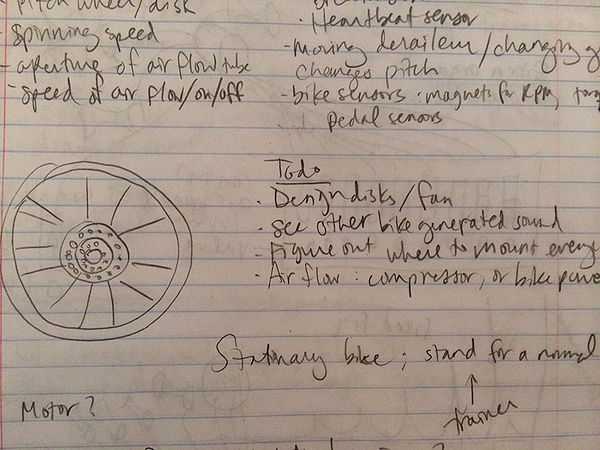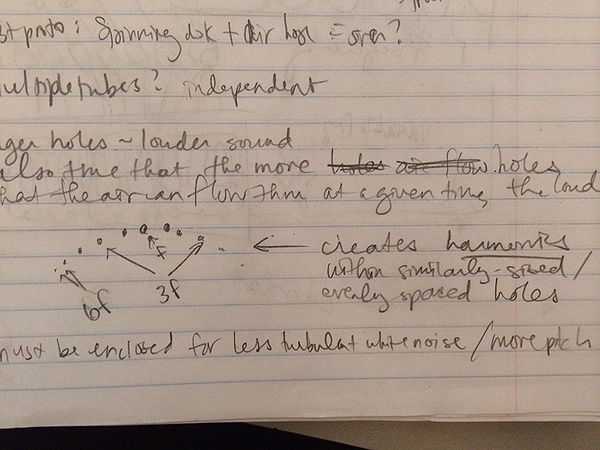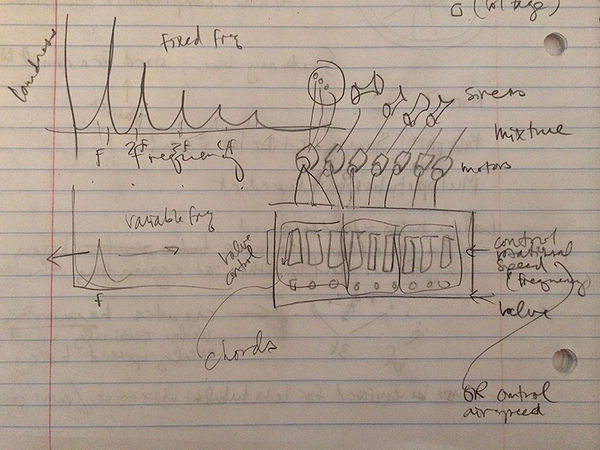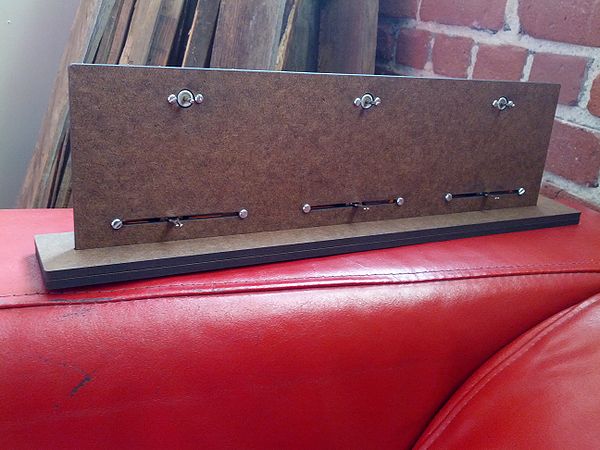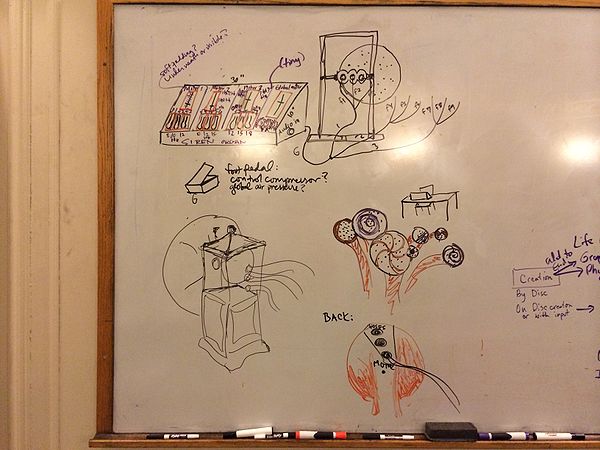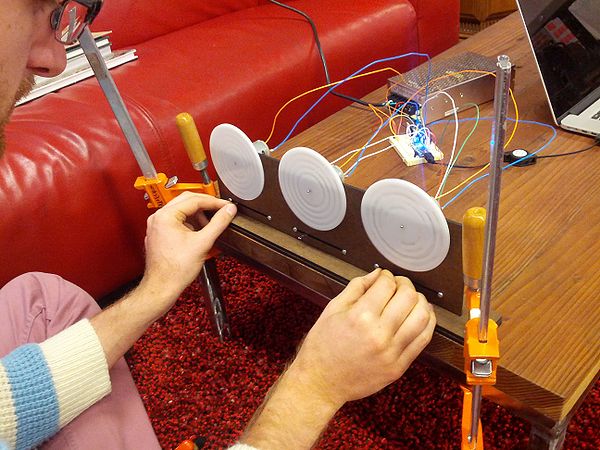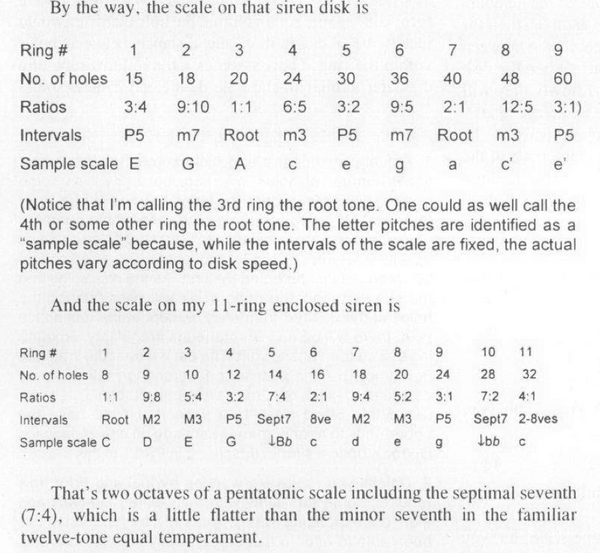Difference between revisions of "The Sound of Sirens"
m (moved OURPROJECTNAME to The Sound of Sirens: yeah) |
|||
| (42 intermediate revisions by 4 users not shown) | |||
| Line 1: | Line 1: | ||
| − | + | == Rough schedule == | |
| − | + | 11/05 - try out new parts bought recently (motor, ball valve, power supply) - buy different valves | |
| + | <br>11/06 - fix air compressor / hoses | ||
| + | <br>11/07 - assemble arduino + faders (for motors) + power supply | ||
| + | <br>11/08 - build software prototype of sound design and determine what other disks to cut | ||
| + | <br>11/09 - continue to fix air compressor / hoses | ||
| + | <br>11/10 - work on controller interface | ||
| + | <br>11/11 - make any other aesthetic/sonic judgments (strobe light?) | ||
| + | <br>11/12 - get small version working (at least 1 motor, air hose, arduino, disk, and faders) | ||
| + | <br>11/13 - scale up, buy anything else we need | ||
| + | <br>11/14 - buy more supplies | ||
| + | <br>11/15 - assemble instrument | ||
| + | <br>11/16 - work on enclosure design | ||
| + | <br>11/17 - build enclosure | ||
| + | <br>11/18 - build enclosure | ||
| + | <br>11/19 - build enclosure | ||
| + | <br>11/20 - debugging, final touches | ||
| + | <br>11/21 - debugging, final touches | ||
| + | <br>11/22 - due date | ||
| + | <br> | ||
| − | + | == Sketches, photos, videos == | |
| − | + | ||
| − | + | ||
| − | + | ||
| − | + | * Video 1: http://instagram.com/p/gLxDNyv3Mz/ | |
| + | * Video 2 (with slomo!): http://www.youtube.com/watch?v=bvfnVCZ2xmw | ||
| + | * Want to create a controller similar to the look/feel of the Peavey 1600x MIDI controller (16 faders and buttons): http://static.kvraudio.com/i/b/peavey__pc-1600x.jpg | ||
| + | * Sketches: | ||
| − | + | Old sketch of "siren disks" mounted to a bike wheel. | |
| − | + | [[File:Bike-siren2.jpeg|600px]] | |
| − | + | Older sketch of the sort of timbre that you can create from different holes in a disk. What looked like it would be amplitude modulation (and probably is, to an extent) is actually a rich harmonic series, according to Bart Hopkin. | |
| − | + | ||
| − | - The | + | [[File:Toneholes.jpeg|600px]] |
| + | |||
| + | The siren organ with one motor and faders controlling the flow of air (pressure/volume). | ||
| + | |||
| + | [[File:1-motor.jpeg|600px]] | ||
| + | |||
| + | The siren organ with faders controlling the speed of the motor--a hybrid design with the above. | ||
| + | |||
| + | [[File:Many-motors.jpeg|600px]] | ||
| + | |||
| + | |||
| + | "Sounds-like" prototype with 3 faders and 3 motors. Just add discs and air: | ||
| + | |||
| + | [[File:3-fader.jpg|600px]] | ||
| + | |||
| + | Some drawings from Gina: | ||
| + | |||
| + | [[File:Gina-drawings.jpeg|600px]] | ||
| + | |||
| + | DS playing with the 3-fader prototype | ||
| + | |||
| + | [[File:DS-3fader.jpg|600px]] | ||
| + | |||
| + | Two helpful tables from an article in EMI about siren construction: | ||
| + | |||
| + | [[File:6-note-siren.png|600px]] | ||
| + | |||
| + | [[File:9-or-11-note-siren.png|600px]] | ||
| + | |||
| + | '''Examples of other work''' | ||
| + | * Victory Siren on the White Holly by Dan Das Mann (Sausalito Lighted Boat Parade): http://oaklandvictorysiren.com/movies/victory_siren_on_the_white_holly.php#more | ||
| + | * Musical Siren by Bart Hopkin: http://windworld.com/features/gallery/musical-siren-built-by-bart-hopkin/ | ||
| + | * Siren Organ by some kid: http://www.youtube.com/watch?v=rAHGhRABI9g (skip to the last 10 seconds): air generated by him, not very loud | ||
| + | * THIS: Siren Organ based on 1915 Loman patent: http://www.youtube.com/watch?v=gSn4EUNXz4M | ||
| + | * Same person as above: The Helmholtz doppelsiren (double siren? for beating paterns): http://www.renebakker.com/2012/works/helmholtz-doppelsiren/ | ||
| + | (* what the hell NAMTA? http://www.namtamusic.com/siren-wi-organ-lessons) | ||
| + | * Vertiges, a pretty serious piece composed for "siren organ": https://vimeo.com/61600835 - not exactly clear how this instrument is a siren (and perhaps its name is given more for its timbre). appears to be sensors in the horns that detect distance to the hand. very beautiful implementation though. more here: http://www.chicagoreader.com/chicago/jean-francois-laporte/Content?oid=915538 - "built instruments with names like the Tu-Yo and the Siren Organ out of air compressors, pneumatic valves, and boat horns" | ||
| + | * not totally related, but I always find the Swarmatron inspiring in its tone; love the continuous oscillators: http://www.youtube.com/watch?v=uuM4yBFI03E | ||
| + | * a homemade pipe organ. We can make individual air valves like he does http://www.sentex.net/~mwandel/organ/organ.html. How it works: http://www.youtube.com/watch?v=d5baNcgIA8o | ||
| + | |||
| + | |||
| + | '''MVP'''. We built a disc with evenly spaced holes attached to a rotating motor and a 9V battery. Blowing on the spinning disc does indeed produce pitch! The motor was rather noisy until we figured out a position to squeeze it (near the top) that makes it virtually silent. Then, we iterated, and attached a potentiometer (fader) to control the voltage. This successfully created a moving pitch that sounded very siren-like! | ||
| + | |||
| + | |||
| + | '''The Plan'''. We want to build a "siren organ" with some faders to control rotational speed of the motor(s) (frequency), other faders to control the applied air pressure (volume), and buttons to control solenoid valves to turn the sirens on/off. | ||
| + | |||
| + | |||
| + | '''Unlimited Resources Vision'''. It's more about unlimited money than time--I think we can achieve something cool. We're ditching the bike idea, I think. | ||
| + | |||
| + | |||
| + | '''Elevator Pitch'''. An "organ of sirens" with the feel of a MIDI instrument. Faders control the volume and frequency of mechanical sirens, while buttons turn them on and off. | ||
| + | |||
| + | |||
| + | '''Materials Needed''' | ||
| + | <br>* motors (6, one for each disk) | ||
| + | <br>* MOSFETs (6) http://www.jameco.com/webapp/wcs/stores/servlet/Product_10001_10001_669951_-1 | ||
| + | <br>* tubes/air hose (24) | ||
| + | <br>* solenoid valves (24): | ||
| + | <br>* 7psi model (might need more): http://www.jameco.com/webapp/wcs/stores/servlet/Product_10001_10001_169835_-1 | ||
| + | <br>* air directional control valves: http://www.mcmaster.com/#air-directional-control-valves/=p6xufn | ||
| + | <br>* arduino (1) | ||
| + | <br>* power source (1?) | ||
| + | http://www.12vadapters.com/adapter/power-supply/12v/10-amp-10a.html | ||
| + | <br>* keys/piano/organ interface (faders + buttons + enclosure) | ||
| + | <br>* disks (12) | ||
| + | <br>* enclosures for the disks (6) | ||
| + | <br>* horns? (6) | ||
| + | <br>* also check out air (pneumatic) controls for air rifles, potato canons, pipe organs, etc. http://www.youtube.com/watch?v=DG6own141z0 shows how to make a homemade check valve with pvc connectors and a bouncy ball. | ||
| + | |||
| + | |||
| + | '''Next Steps'''. The next steps are to build a 5-fader, 4-button, 1-motor model, where 4 faders are devoted to air hoses over the individual rings of 1 disk (different pitches) and control the air pressure of each hose, and 1 fader is dedicated to the spin of the motor. The 4 faders could possibly control ball valves to partially open/close the air hoses as opposed to flow, which we do not have a good grasp of how to control (cheaply; a regulator might work). The buttons could also serve as the valve control, or could power on/off the air supply. | ||
| + | |||
| + | We need to figure out how fast we want the individual motors to go, and how much power they need to all spin at the same speed. This will let us tune our organ. | ||
Latest revision as of 00:18, 3 November 2014
Rough schedule
11/05 - try out new parts bought recently (motor, ball valve, power supply) - buy different valves
11/06 - fix air compressor / hoses
11/07 - assemble arduino + faders (for motors) + power supply
11/08 - build software prototype of sound design and determine what other disks to cut
11/09 - continue to fix air compressor / hoses
11/10 - work on controller interface
11/11 - make any other aesthetic/sonic judgments (strobe light?)
11/12 - get small version working (at least 1 motor, air hose, arduino, disk, and faders)
11/13 - scale up, buy anything else we need
11/14 - buy more supplies
11/15 - assemble instrument
11/16 - work on enclosure design
11/17 - build enclosure
11/18 - build enclosure
11/19 - build enclosure
11/20 - debugging, final touches
11/21 - debugging, final touches
11/22 - due date
Sketches, photos, videos
- Video 1: http://instagram.com/p/gLxDNyv3Mz/
- Video 2 (with slomo!): http://www.youtube.com/watch?v=bvfnVCZ2xmw
- Want to create a controller similar to the look/feel of the Peavey 1600x MIDI controller (16 faders and buttons): http://static.kvraudio.com/i/b/peavey__pc-1600x.jpg
- Sketches:
Old sketch of "siren disks" mounted to a bike wheel.
Older sketch of the sort of timbre that you can create from different holes in a disk. What looked like it would be amplitude modulation (and probably is, to an extent) is actually a rich harmonic series, according to Bart Hopkin.
The siren organ with one motor and faders controlling the flow of air (pressure/volume).
The siren organ with faders controlling the speed of the motor--a hybrid design with the above.
"Sounds-like" prototype with 3 faders and 3 motors. Just add discs and air:
Some drawings from Gina:
DS playing with the 3-fader prototype
Two helpful tables from an article in EMI about siren construction:
Examples of other work
- Victory Siren on the White Holly by Dan Das Mann (Sausalito Lighted Boat Parade): http://oaklandvictorysiren.com/movies/victory_siren_on_the_white_holly.php#more
- Musical Siren by Bart Hopkin: http://windworld.com/features/gallery/musical-siren-built-by-bart-hopkin/
- Siren Organ by some kid: http://www.youtube.com/watch?v=rAHGhRABI9g (skip to the last 10 seconds): air generated by him, not very loud
- THIS: Siren Organ based on 1915 Loman patent: http://www.youtube.com/watch?v=gSn4EUNXz4M
- Same person as above: The Helmholtz doppelsiren (double siren? for beating paterns): http://www.renebakker.com/2012/works/helmholtz-doppelsiren/
(* what the hell NAMTA? http://www.namtamusic.com/siren-wi-organ-lessons)
- Vertiges, a pretty serious piece composed for "siren organ": https://vimeo.com/61600835 - not exactly clear how this instrument is a siren (and perhaps its name is given more for its timbre). appears to be sensors in the horns that detect distance to the hand. very beautiful implementation though. more here: http://www.chicagoreader.com/chicago/jean-francois-laporte/Content?oid=915538 - "built instruments with names like the Tu-Yo and the Siren Organ out of air compressors, pneumatic valves, and boat horns"
- not totally related, but I always find the Swarmatron inspiring in its tone; love the continuous oscillators: http://www.youtube.com/watch?v=uuM4yBFI03E
- a homemade pipe organ. We can make individual air valves like he does http://www.sentex.net/~mwandel/organ/organ.html. How it works: http://www.youtube.com/watch?v=d5baNcgIA8o
MVP. We built a disc with evenly spaced holes attached to a rotating motor and a 9V battery. Blowing on the spinning disc does indeed produce pitch! The motor was rather noisy until we figured out a position to squeeze it (near the top) that makes it virtually silent. Then, we iterated, and attached a potentiometer (fader) to control the voltage. This successfully created a moving pitch that sounded very siren-like!
The Plan. We want to build a "siren organ" with some faders to control rotational speed of the motor(s) (frequency), other faders to control the applied air pressure (volume), and buttons to control solenoid valves to turn the sirens on/off.
Unlimited Resources Vision. It's more about unlimited money than time--I think we can achieve something cool. We're ditching the bike idea, I think.
Elevator Pitch. An "organ of sirens" with the feel of a MIDI instrument. Faders control the volume and frequency of mechanical sirens, while buttons turn them on and off.
Materials Needed
* motors (6, one for each disk)
* MOSFETs (6) http://www.jameco.com/webapp/wcs/stores/servlet/Product_10001_10001_669951_-1
* tubes/air hose (24)
* solenoid valves (24):
* 7psi model (might need more): http://www.jameco.com/webapp/wcs/stores/servlet/Product_10001_10001_169835_-1
* air directional control valves: http://www.mcmaster.com/#air-directional-control-valves/=p6xufn
* arduino (1)
* power source (1?)
http://www.12vadapters.com/adapter/power-supply/12v/10-amp-10a.html
* keys/piano/organ interface (faders + buttons + enclosure)
* disks (12)
* enclosures for the disks (6)
* horns? (6)
* also check out air (pneumatic) controls for air rifles, potato canons, pipe organs, etc. http://www.youtube.com/watch?v=DG6own141z0 shows how to make a homemade check valve with pvc connectors and a bouncy ball.
Next Steps. The next steps are to build a 5-fader, 4-button, 1-motor model, where 4 faders are devoted to air hoses over the individual rings of 1 disk (different pitches) and control the air pressure of each hose, and 1 fader is dedicated to the spin of the motor. The 4 faders could possibly control ball valves to partially open/close the air hoses as opposed to flow, which we do not have a good grasp of how to control (cheaply; a regulator might work). The buttons could also serve as the valve control, or could power on/off the air supply.
We need to figure out how fast we want the individual motors to go, and how much power they need to all spin at the same speed. This will let us tune our organ.
